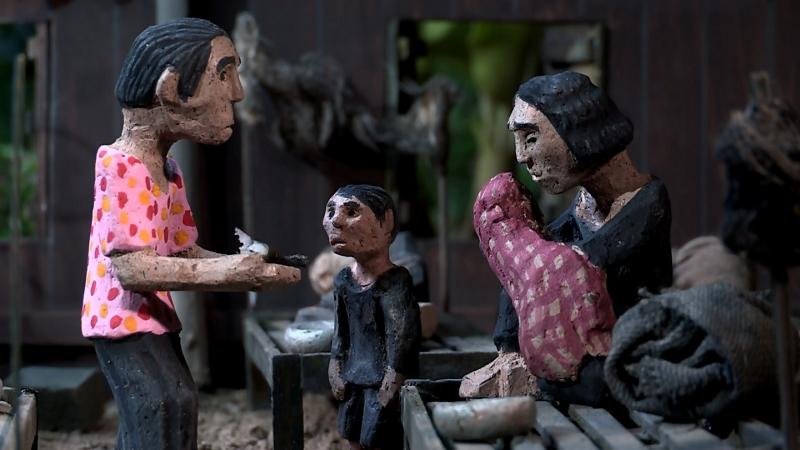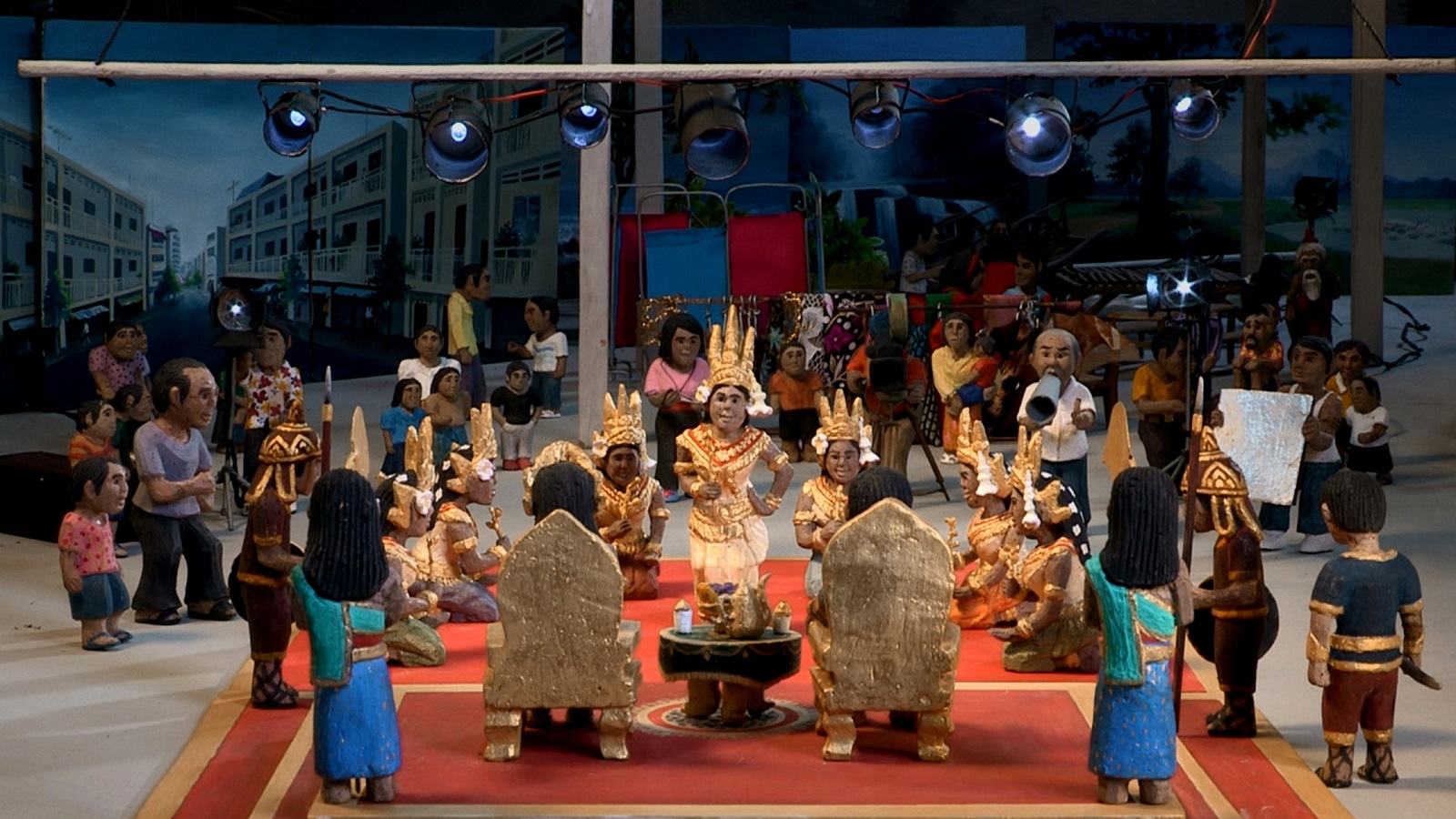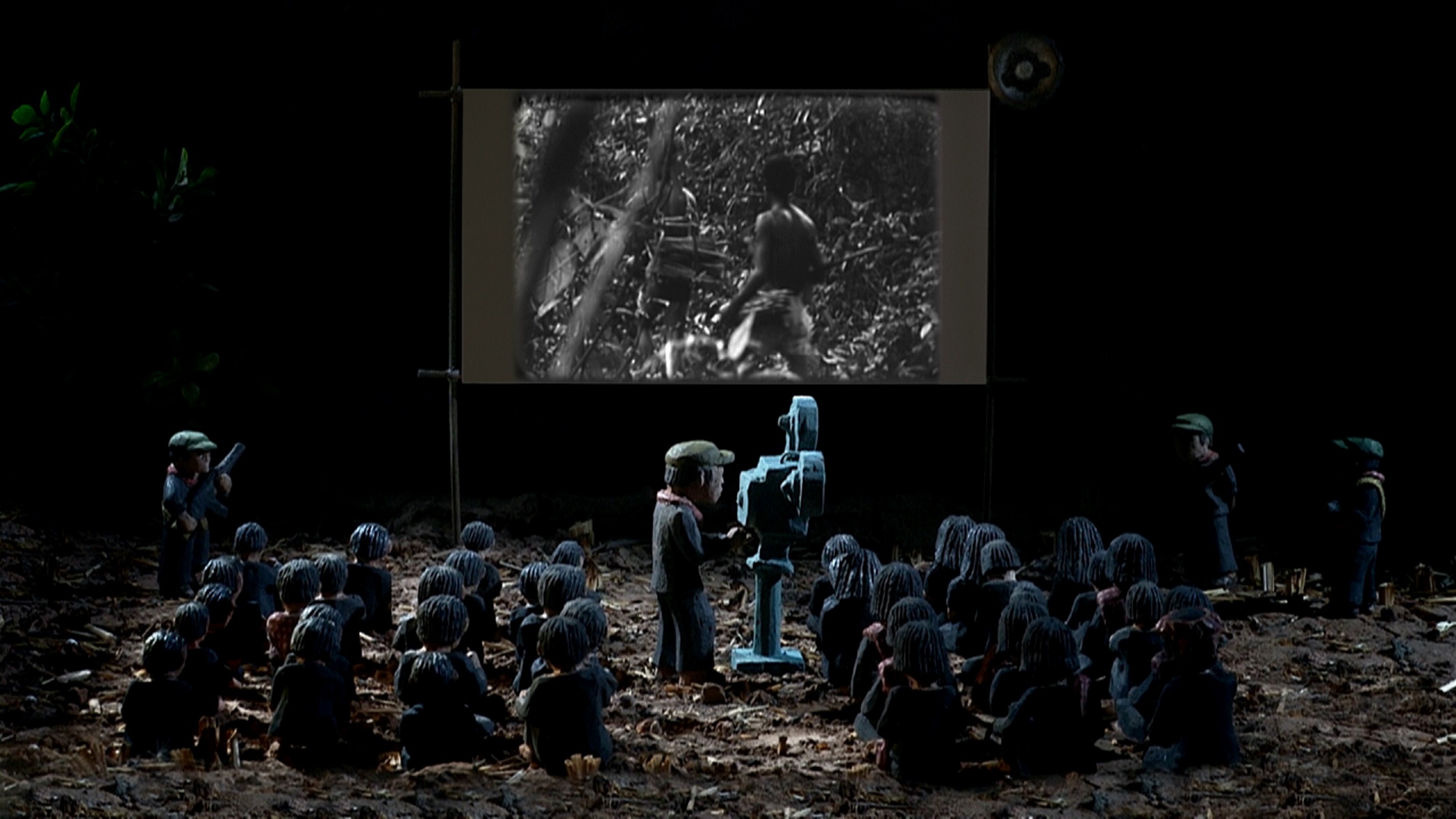The Missing Picture | reviews, news & interviews
The Missing Picture
The Missing Picture
Cambodian genocide retold in striking form

History has been told in many ways on film, but Rithy Panh achieves something new, something unique and unsettling, in The Missing Picture.
The director has tackled this momentous subject before in a number of films, both documentary and fiction. The Missing Picture adds a new element, the use of clay figurines, fashioned and painted before our eyes, depicting family members and others in a series of still tableaux that are combined together with plentiful documentary material drawn from Khmer Rouge archives. It’s told to a mesmerising but quiet narrative (in the voice of Randal Douc): the unlikely result can only be compared to something like a story from Solzhenitsyn, told in stop animation that never starts, with an occasional visual style that Chagall would have understood, and meditative overvoice commentary (recalling, somehow, Agnès Varda in The Gleaners and I).
It's also a film that meditates on cinema itself, right from its opening shots of abandoned, decaying boxes of film stock (a frame of reference that possibly helped it towards victory in the 'Un Certain Regard' programme at Cannes last year). There’s the riddle behind the title itself, to which each viewer must provide their own answer. Is the missing picture the image depicting what really happened, that is never to be found in the Khmer Rouge sources? Or the story elements that were never recorded (only recreated here by the clay figurines) as we witness the death of the narrator’s father, who starved himself to death in an act of defiance (the only assertion of identity that remained under such desperate conditions), and mother, who later died in a hospital as her son attempted to find food for her (main picture, above).
 Then there’s the literal recreation of film memories. Pre-1975 life is remembered as a time of plenty (“I remember abundance,” the narrator recalls), whether in the quotidian rituals of family and home life, or in a scene from an elaborately crafted film set (pictured above: incidentally, Cambodia’s King Norodom Sihanouk, whom the Khmer Rouge ousted, was a cinema fanatic). The motif returns in a later scene, this time within the indoctrination camps, where screenings of official documentaries concluded slavish working days in the fields (“the colour has vanished”: pictured below).
Then there’s the literal recreation of film memories. Pre-1975 life is remembered as a time of plenty (“I remember abundance,” the narrator recalls), whether in the quotidian rituals of family and home life, or in a scene from an elaborately crafted film set (pictured above: incidentally, Cambodia’s King Norodom Sihanouk, whom the Khmer Rouge ousted, was a cinema fanatic). The motif returns in a later scene, this time within the indoctrination camps, where screenings of official documentaries concluded slavish working days in the fields (“the colour has vanished”: pictured below).
There are recurring long shots of waves battering a coastline, playing perhaps on the idea that this water is washing away the images, the “pictures” (echoing somehow what Doris Lessing wrote, in a literary context, about the mujahedin war in Afghanistan, “the wind blows away our words”). Against all the destruction, the desecration of the rich tones of life into chilly black and white propaganda, there is set the personal recreation of that world, reconstituted in the coloured clay figures that people the panoramas in which they are placed, motionless as the camera weaves between them.
 Somewhere in there, too, remains the responsibility of the artist to survive, as Panh did, to tell the story. To assimilate and reject the false images, to create the new images – to reach a personal viewpoint. Which may involve admitting, finally, that there will always be a “missing picture”.
Somewhere in there, too, remains the responsibility of the artist to survive, as Panh did, to tell the story. To assimilate and reject the false images, to create the new images – to reach a personal viewpoint. Which may involve admitting, finally, that there will always be a “missing picture”.
If all that sounds abstract, theoretical, it’s not. The Missing Picture is a cinematic experience that opens up, rather than closes down its material, and affirms humanity against all terrible odds.
Overleaf: watch the trailer for The Missing Picture
The future of Arts Journalism
You can stop theartsdesk.com closing!
We urgently need financing to survive. Our fundraising drive has thus far raised £49,000 but we need to reach £100,000 or we will be forced to close. Please contribute here: https://gofund.me/c3f6033d
And if you can forward this information to anyone who might assist, we’d be grateful.

Subscribe to theartsdesk.com
Thank you for continuing to read our work on theartsdesk.com. For unlimited access to every article in its entirety, including our archive of more than 15,000 pieces, we're asking for £5 per month or £40 per year. We feel it's a very good deal, and hope you do too.
To take a subscription now simply click here.
And if you're looking for that extra gift for a friend or family member, why not treat them to a theartsdesk.com gift subscription?
more Film
 Bugonia review - Yorgos Lanthimos on aliens, bees and conspiracy theories
Emma Stone and Jesse Plemons excel in a marvellously deranged black comedy
Bugonia review - Yorgos Lanthimos on aliens, bees and conspiracy theories
Emma Stone and Jesse Plemons excel in a marvellously deranged black comedy
 theartsdesk Q&A: director Kelly Reichardt on 'The Mastermind' and reliving the 1970s
The independent filmmaker discusses her intimate heist movie
theartsdesk Q&A: director Kelly Reichardt on 'The Mastermind' and reliving the 1970s
The independent filmmaker discusses her intimate heist movie
 Blu-ray: Wendy and Lucy
Down-and-out in rural Oregon: Kelly Reichardt's third feature packs a huge punch
Blu-ray: Wendy and Lucy
Down-and-out in rural Oregon: Kelly Reichardt's third feature packs a huge punch
 The Mastermind review - another slim but nourishing slice of Americana from Kelly Reichardt
Josh O'Connor is perfect casting as a cocky middle-class American adrift in the 1970s
The Mastermind review - another slim but nourishing slice of Americana from Kelly Reichardt
Josh O'Connor is perfect casting as a cocky middle-class American adrift in the 1970s
 Springsteen: Deliver Me From Nowhere review - the story of the Boss who isn't boss of his own head
A brooding trip on the Bruce Springsteen highway of hard knocks
Springsteen: Deliver Me From Nowhere review - the story of the Boss who isn't boss of his own head
A brooding trip on the Bruce Springsteen highway of hard knocks
 The Perfect Neighbor, Netflix review - Florida found-footage documentary is a harrowing watch
Sundance winner chronicles a death that should have been prevented
The Perfect Neighbor, Netflix review - Florida found-footage documentary is a harrowing watch
Sundance winner chronicles a death that should have been prevented
 Blu-ray: Le Quai des Brumes
Love twinkles in the gloom of Marcel Carné’s fogbound French poetic realist classic
Blu-ray: Le Quai des Brumes
Love twinkles in the gloom of Marcel Carné’s fogbound French poetic realist classic
 Frankenstein review - the Prometheus of the charnel house
Guillermo del Toro is fitfully inspired, but often lost in long-held ambitions
Frankenstein review - the Prometheus of the charnel house
Guillermo del Toro is fitfully inspired, but often lost in long-held ambitions
 London Film Festival 2025 - a Korean masterclass in black comedy and a Camus classic effectively realised
New films from Park Chan-wook, Gianfranco Rosi, François Ozon, Ildikó Enyedi and more
London Film Festival 2025 - a Korean masterclass in black comedy and a Camus classic effectively realised
New films from Park Chan-wook, Gianfranco Rosi, François Ozon, Ildikó Enyedi and more
 After the Hunt review - muddled #MeToo provocation
Julia Roberts excels despite misfiring drama
After the Hunt review - muddled #MeToo provocation
Julia Roberts excels despite misfiring drama
 Ballad of a Small Player review - Colin Farrell's all in as a gambler down on his luck
Conclave director Edward Berger swaps the Vatican for Asia's sin city
Ballad of a Small Player review - Colin Farrell's all in as a gambler down on his luck
Conclave director Edward Berger swaps the Vatican for Asia's sin city
 London Film Festival 2025 - Bradley Cooper channels John Bishop, the Boss goes to Nebraska, and a French pandemic
... not to mention Kristen Stewart's directing debut and a punchy prison drama
London Film Festival 2025 - Bradley Cooper channels John Bishop, the Boss goes to Nebraska, and a French pandemic
... not to mention Kristen Stewart's directing debut and a punchy prison drama

Add comment